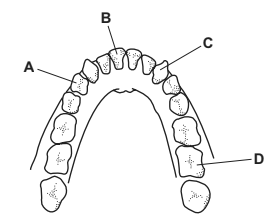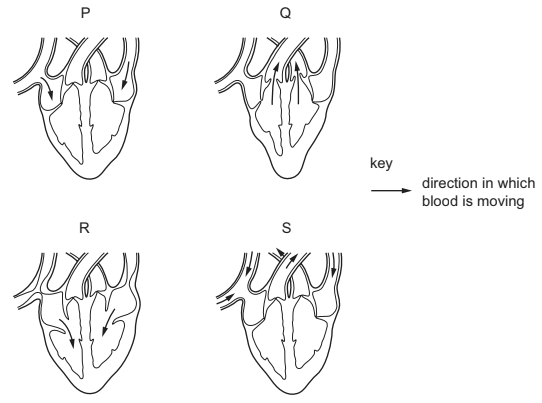Question
The diagram shows a tooth with signs of decay.

What has made the hole in the enamel of the tooth?
-
acid
-
saliva
-
sugar
-
toothpaste
Answer/Explanation
A
Acid can contribute to the formation of a hole in the enamel of a tooth.
Acidic substances, such as certain foods and beverages (e.g., citrus fruits, sodas, sports drinks) and gastric acid from conditions like acid reflux, can erode the tooth enamel over time. This erosion weakens the enamel, making it more susceptible to decay. So, the most correct option is (A) acid.
Question
The diagram shows the teeth of the lower jaw of a human.
Which tooth is a premolar?

▶️Answer/Explanation
A
The dental formula for humans is as follows:
2-1-2-3/2-1-2-3
This means that in each quadrant of the mouth (upper and lower), we have:
• 2 incisors
• 1 canine
• 2 premolars
• 3 molars (including the third molars, commonly known as wisdom teeth)
Therefore, from the diagram of the lower half of the jaw, A represents premolars.
Question
The diagram shows a human tooth with an area of decay.

What is likely to have caused the decay?
A acids released by bacteria
B digestion of the tooth by bacteria
C excess of fat in the food
D lack of fibre in the food
▶️Answer/Explanation
A
The likely cause of the decay shown in the diagram of the human tooth is acids released by bacteria. Tooth decay, also known as dental caries, is a process that occurs when bacteria in the mouth break down food particles, especially sugars and carbohydrates, and produce acids as a byproduct. These acids gradually erode the tooth enamel, leading to the formation of cavities or areas of decay.
The diagram indicating an area of decay suggests that the enamel has been affected by the acidic environment created by bacteria in the mouth. This aligns with option A, which states that acids released by bacteria are likely the cause of the decay.
Question
The diagram shows the teeth of the lower jaw of a human.
Which tooth is an incisor?

▶️Answer/Explanation
B
By the dental formula of each half of the jaw, 2123/2123 .
This means that in each half of the jaw, there are 2 incisors, 1 canine, 2 premolars, and 3 molars. Together, a complete set of teeth in the human mouth would have:
Upper jaw: 2 incisors, 1 canine, 2 premolars, and 3 molars on each side, making a total of 2×2=4 incisors, 2 canines, 2 premolars, and 3 molars for the upper jaw. Lower jaw: 2 incisors, 1 canine, 2 premolars, and 3 molars on each side, making a total of 2×2=4 incisors, 2 canines, 2 premolars, and 3 molars for the lower jaw.
So, in a complete human dentition, there would be 4 incisors in the lower half of the jaw (first two on each side represent the incisors) and a total of 8 incisors in both upper and lower jaws combined. Similarly, there would be 4 canines, 4 premolars, and 6 molars in total (both sides combined).
In the above diagram, The first two teeth of the lower half of the jaw represents the incisors. Therefore, B is the correct option.
Question
The diagrams show four different stages in one heart beat.

What is the correct order for the stages after stage P?
A Q → R → S
B R → Q → S
C R → S → Q
D S → R → Q
▶️Answer/Explanation
B
The four different stages in one heartbeat refer to the cardiac cycle, which represents the complete sequence of events that occur during one heartbeat. The correct order of these stages is as follows:
1. Atrial Contraction (Atrial Systole): The cardiac cycle begins with the contraction of the atria, the two upper chambers of the heart. This contraction pushes blood into the ventricles.
2. Ventricular Contraction (Ventricular Systole): After the atrial contraction, the ventricles, the two lower chambers of the heart, contract. This forces blood out of the heart into the pulmonary artery (from the right ventricle) and the aorta (from the left ventricle) to be distributed throughout the body.
3. Atrial Relaxation (Atrial Diastole): Following the ventricular contraction, the atria start to relax. As they relax, blood begins to flow into the atria from the veins, preparing for the next cardiac cycle.
4. Ventricular Relaxation (Ventricular Diastole): Finally, both the atria and ventricles are in a relaxed state. The ventricles receive blood from the atria, and the whole heart is ready for another cycle as it fills up with blood from the body and lungs.
This sequence of events repeats with every heartbeat, ensuring continuous blood circulation throughout the body. Keep in mind that the heart’s electrical system and valves play essential roles in coordinating and regulating these stages to maintain an effective and efficient pumping action.
Question
The diagram shows the four types of human tooth.

Which teeth are used for cutting rather than grinding food?
A 1 and 2 B 2 and 3 C 3 and 4 D 4 and 1
▶️Answer/Explanation
A
The answer is A: Teeth 1 (incisors) and 2 (canines) are used for cutting rather than grinding food.
Incisors are the front teeth in the mouth, and their main function is to cut food into smaller, more manageable pieces. They have a sharp, chisel-like edge that allows for effective cutting.
Canines are located on either side of the incisors. They have a more pointed shape and are used for tearing and gripping food.
Teeth 3 (premolars) and 4 (molars) are primarily used for grinding and chewing food. Therefore, when it comes to cutting food, the incisors (1) and canines (2) are the teeth that play the most significant role.
Question
Why does chewing food speed up digestion?
A Bacteria in the food are killed.
B Food is mixed with protease.
C The surface area of the food is increased.
D The taste of food is improved.
▶️Answer/Explanation
C
The correct answer is C: The surface area of the food is increased.
Chewing food plays a crucial role in the process of digestion. When you chew, your teeth break down the food into smaller, more manageable pieces. This process increases the surface area of the food, exposing more of its particles to digestive enzymes and allowing for more efficient digestion.
Question
The diagram shows a tooth with signs of decay.

What has made the hole in the enamel of the tooth?
A acid
B saliva
C sugar
D toothpaste
 Answer/Explanation
Answer/Explanation
A
Acid can contribute to the formation of a hole in the enamel of a tooth.
Acidic substances, such as certain foods and beverages (e.g., citrus fruits, sodas, sports drinks) and gastric acid from conditions like acid reflux, can erode the tooth enamel over time. This erosion weakens the enamel, making it more susceptible to decay. So, the most correct option is (A) acid.
Question
The diagram shows a human tooth.
Which statement best describes the function of this tooth?
A It bites into food.
B It cuts food.
C It grinds food.
D It tears food.
▶️Answer/Explanation
C
The function of the tooth depicted in the diagram is best described as grinding food. Grinding teeth, also known as molars and premolars, have a flatter surface with multiple cusps designed for crushing and grinding food particles. These teeth are located at the back of the mouth and are responsible for breaking down food into smaller, more manageable pieces for swallowing and digestion. Therefore, option C, “It grinds food,” is the most accurate description of the tooth’s function.
Question
The diagram shows a type of tooth.

Use the key to identify the tooth.
1 the root is divided into two parts ……………………………………………………… go to 2
the root is not divided into two parts ………………………………………………… go to 3
2 the height of the crown is greater than the length of the root ………………. A
the height of the crown is less than the length of the root …………………… B
3 flattened crown …………………………………………………………………………….. C
ridged crown ………………………………………………………………………………… D
Answer/Explanation
Ans:
B
Question
The graph shows pH changes in the mouth after eating.

Why is it a good idea to brush teeth after eating?
A Acidic conditions help bacteria to grow.
B Acids dissolve tooth enamel.
C Alkaline conditions help bacteria to grow.
D Alkalis dissolve tooth enamel.
Answer/Explanation
Ans
B
Question
In which part of the body of a mammal does mechanical digestion occur?
A gall bladder
B liver
C mouth
D pancreas
Answer/Explanation
Ans
C
Question
The diagram shows a tooth with signs of decay.

What has made the hole in the enamel of the tooth?
acid
saliva
sugar
toothpaste
▶️Answer/Explanation
A
Acid can contribute to the formation of a hole in the enamel of a tooth.
Acidic substances, such as certain foods and beverages (e.g., citrus fruits, sodas, sports drinks) and gastric acid from conditions like acid reflux, can erode the tooth enamel over time. This erosion weakens the enamel, making it more susceptible to decay. So, the most correct option is (A) acid.
